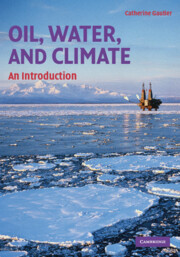Book contents
- Frontmatter
- Contents
- Foreword
- Introduction
- 1 Overview
- 2 Carbon Dioxide Emissions, Global Warming, and Water Resources
- 3 Population, Environmental Impacts, and Climate Change
- 4 Carbon Cycle and the Human Impact
- 5 Peak Oil, Energy, Water, and Climate
- 6 Oil Consumption and CO2 Emissions from Transportation
- 7 Oil, Economy, Power, and Conflicts
- 8 Energy Alternatives and Their Connection to Water and Climate
- 9 The Water Cycle and Global Warming
- 10 Fresh Water Availability, Sanitation Deficit, and Water Usage: Connection to Energy and Global Warming
- 11 Rivers, Lakes, Aquifers, and Dams: Relation to Energy and Climate
- 12 Water Contamination, Energy, and Climate
- 13 Geopolitics of Water and the International Situation
- 14 Water Alternatives
- 15 Global Climate Change: Observations, Modeling, and Predictions
- 16 Energy and Water Challenges and Solutions in a Changing Climate Framework: Commonality, Differences, and Connections
- References
- Index
9 - The Water Cycle and Global Warming
Published online by Cambridge University Press: 05 September 2012
- Frontmatter
- Contents
- Foreword
- Introduction
- 1 Overview
- 2 Carbon Dioxide Emissions, Global Warming, and Water Resources
- 3 Population, Environmental Impacts, and Climate Change
- 4 Carbon Cycle and the Human Impact
- 5 Peak Oil, Energy, Water, and Climate
- 6 Oil Consumption and CO2 Emissions from Transportation
- 7 Oil, Economy, Power, and Conflicts
- 8 Energy Alternatives and Their Connection to Water and Climate
- 9 The Water Cycle and Global Warming
- 10 Fresh Water Availability, Sanitation Deficit, and Water Usage: Connection to Energy and Global Warming
- 11 Rivers, Lakes, Aquifers, and Dams: Relation to Energy and Climate
- 12 Water Contamination, Energy, and Climate
- 13 Geopolitics of Water and the International Situation
- 14 Water Alternatives
- 15 Global Climate Change: Observations, Modeling, and Predictions
- 16 Energy and Water Challenges and Solutions in a Changing Climate Framework: Commonality, Differences, and Connections
- References
- Index
Summary
Water naturally cycles through different reservoirs where it remains for various amounts of time (residence time) in each reservoir, giving the impression that there is plenty of water available. Most of the water, however, is either saline or stored in ice. The spatial distribution of the components of the cycle – precipitation and evaporation (including evapotranspiration) – shows its strong link to atmospheric circulation and, in turn, climate.
Introduction
Water is ubiquitous on the planet Earth, and within the solar system, Earth can be uniquely characterized as the water planet. The presence of water in its three states – solid, liquid, and water vapor – is a basic characteristic of Earth, a necessary requirement for life, and, to a large extent, a controlling factor of climate and the climate response to extraneous influences, including human activities.
Most of the water on Earth is located in the oceans that cover more than 70% of the planetary surface. The oceans are where life originated about 3.5 billion years ago, and they remain home for a great many living species. The availability of fresh water, which makes life possible on Earth's continents, results from the cycling of water: evaporation from the ocean into the atmosphere, which leaves salt behind, and precipitation from the atmosphere back to the surface. The water falling over land is stored in surface water bodies like lakes or artificial reservoirs, runs off in rivers, or percolates through soil to fill underground reservoirs or aquifers where it can be extracted as the need arises.
- Type
- Chapter
- Information
- Oil, Water, and ClimateAn Introduction, pp. 168 - 186Publisher: Cambridge University PressPrint publication year: 2008



